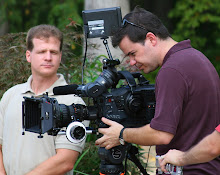We've been shooting a lot of green screen footage lately. One of our clients has a web site with an online coach, and we shoot her in front of green, then send the footage to their Flash artist who keys the footage over whatever background they're currently using on the site.
It's a fairly straight-forward assignment, but I find it's important to be extra careful when I'm shooting green-screen footage (or anything that's going to be used for effects) when the footage is going to be composited by someone else. This is especially true when you don't know what tools they have available. Working in After Effects and being spoiled by how easy it is to pull a nice key using Keylight, you can forget that not every keying tool is so precise and powerful. So be nice, and be sure to send them clean, evenly lit footage.
My online-friend Jonas Hummelstrand has posted an excellent guide for getting great green and bluescreen footage at his blog, General Specialist. Check it out, then come on back here and I'll share with you a silly mistake I recently made while shooting greenscreen.
Okay, so I was recently shooting greenscreen segments for our TripFlix project, using our Panasonic SDX-900 DVCPro 50 camera. Shooting in DVCPro 50 is much better than standard DVCPro (or DV, which is essentially the same codec) because DV50 has twice the data rate (50 mbps vs. 25 mbps) and uses 4:2:2 color sampling, instead of the 4:1:1 sampling of standard DV. More chroma resolution means more information for the keying software to use. (These numbers are becoming fuzzy in the HD world, FYI...but that's a subject for a future post.)
Here's the bone-headed mistake I made. 90% of the time, when shooting with the SDX-900, I have a black stocking net mounted between the lens and the camera body. This is an old camera trick that helps soften the image, and puts a nice glow on the highlights in your image. When you're shooting 24p 16x9, having this net helps give you more of that film look we all seem to covet. Here's an example of what it does for you - See how that highlight on the wheel has a nice glow, yet the image doesn't have an over-fogged effect? That's what the black net does.
See how that highlight on the wheel has a nice glow, yet the image doesn't have an over-fogged effect? That's what the black net does.
By this point you're probably one step ahead of me, and can figure out what I did to screw up, er, make my greenscreen shot more challenging. Yep, I shot with the net still attached to the camera, and I didn't even realize it until I'd started trying to pull a good key in After Effects.
See the hits on Alex's helmet, and the nice glow they have? Not good for keying, my friends, not good. In fact, it's not just those hits, everything in the image has a subtle glow.
In the end, I spent more time than I normally do in Keylight, tweaking, and I was able to pull a pretty good key. Not my best work (the edges are a tad soft for my liking), but certainly usable.
I learned my lesson, though. Not remembering to take thirty seconds to remove the net cost me a lot of time working with more challenging footage.
Monday, January 14, 2008
Green Screen headache
Posted by
Dave Bittner
at
10:38 AM
![]()
![]()
Subscribe to:
Post Comments (Atom)


No comments:
Post a Comment